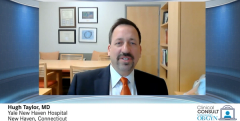
Future Directions for Endometriosis Treatment
An expert reproductive endocrinologist explores the future treatment landscape for patients with endometriosis.
Episodes in this series

Robert N. Taylor, MD, PhD: What do we think is going to change the landscape in the coming decade now that we've made this breakthrough into orally available agents that for the last 20 or 30 years have been peptide drugs that we needed to inject? Now that these are orally available, what do we see happening next? I would say that these similar medications based on some of the structural components that we see in elagolix are things that we can anticipate in probably more dosage regimens, as well as the possibility of prolonging some of these treatments. I should have pointed out that we're limited by the FDA (United States Food and Drug Administration], in terms of the length of time that we can provide some of these prescriptions because of the concern for osteopenia and bone loss. The low-dose regimen, 150 milligrams, has actually been approved for up to 2 years, which is great. That's been nice, but many of these women will continue to have symptoms that go beyond just a period of 2 years. Thus, options for longer, more protracted therapy would be nice. And maybe some of these newer medications or with add-back regimens where we can give hormones back, some estrogen and progesterone, to try to help sustain bone density, for example, and improve hot flashes are things that we can anticipate. Relative to that, I should point out that many of us have been using add-back therapy, even though it's not been formally FDA-approved for many, many years. It's been probably a decade or so, but Dr Robert Casper,MD, FRCSC, REI at the Toronto Centre for Advanced Reproductive Technology] had a nice paper describing his own experience using leuprolide and add-back hormone therapy for more than 10 years in many of his patients. Hence, we feel that there are going to be safe ways of doing this add-back even if they're not formally FDA-approved.
Other developments that I think we can anticipate are that there's been a real interest in developing therapeutics for endometriosis that don't target the hypothalamic pituitary ovarian axis. All of the medications that I've described to you, today, with the exception of the NSAIDs [nonsteroidal anti-inflammatory drugs], actually target that axis if we're using combined oral contraceptive pills, Danazol, progestins, GnRH [gonadotropin-releasing hormone] super agonists or GnRH antagonists, they're all designed really to shut down that axis. Because we know that there are a lot of inflammatory components to the pathophysiology of endometriosis, many of us have been interested in hoping to develop medications that target the inflammation that might allow normal hormone responses to occur. Thus, normal ovarian hormone production might be tolerated if we had ways to reduce the inflammatory pain that's associated with endometriosis. That's been a major focus of work in my own laboratory, but also in that of many others who have studied endometriosis. Hence, there's hope that there could be drugs that are targeted either against specific inflammatory factors that are critical to endometriosis symptoms, and even pain therapies, new pain-directed drugs that might actually reduce in a more direct effect pain that is generated within these endometriotic lesions that could actually allow for women to have normal menstrual function at a time while they're taking these medications. What that potentially could allow, obviously, would require lots of safety data and experience, but ultimately, we're hoping that there'll be medications that actually allow women to become pregnant while they're treating the painful symptoms of their endometriosis. At the current time, we don't have that kind of flexibility. Essentially, all of the drugs that we use can have an important impact on the reproductive function, even though I've mentioned that we can't count on some of these new-generation antagonists to be effective contraceptives under these conditions, but they do tend to impair fertility rather than enhance it. Thus, that would be something I think in the future that we'd like to look forward to.
To conclude, I've tried to give you a little bit of a sense of the kind of history of pharmacotherapy as it has evolved in the treatment of endometriosis from back in the early time of my own training—and I do remember using danazol quite a bit in the old days—through the discovery of GnRH, its structure, and its function as a really critical regulatory hormone in the hypothalamic pituitary ovarian axis. And now, the manipulation of that molecule through the development, first through superagonist drugs, and now with orally available antagonist drugs. We're using elagolix as an example, but as I've noted, we'll have some, I think, sister compounds before too long, that may give us even more options in terms of dosing, length of treatment, hormonal add-back options to try to mitigate some of the adverse effects and potential adverse effects that women have described so far using these medications. Thanks for your attention.
Transcript Edited for Clarity
Newsletter
Get the latest clinical updates, case studies, and expert commentary in obstetric and gynecologic care. Sign up now to stay informed.






